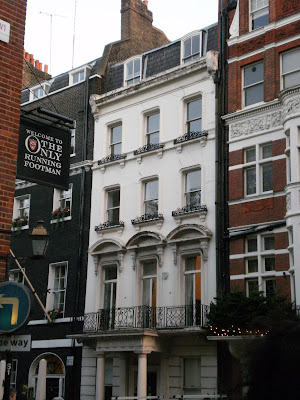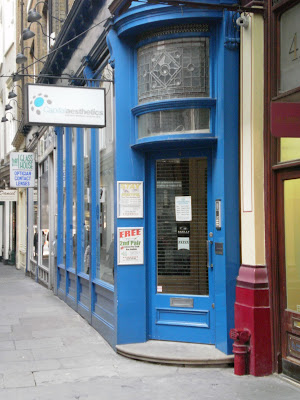Some days are just bad days. There's not enough hot water for your shower, the milk that you have to use is on the wrong side of the use by date, its raining and your shoes get wet, there are no seats on the Tube, you're late, you have to have a ham sandwich for lunch AGAIN, you don't have change for chocolate, you stare at and re-write the same five sentences for eight hours, one of your limbs gets caught in the closing Tube door, that amazing thing you were going to have for dinner has mysteriously disappeared, and then you can't sleep. We all have days like this. What matters is that you know what to do when one springs upon you.
Do not, I repeat, DO NOT do any of the following: listen to Neil Young's Oh Lonesome Me or Cat Power's Hate; watch romantic comedies (you think its going to make you better but then you're watching a ridiculous story about an beautiful girl who still can't get a boyfriend and then she gets one and amazingly all her life problems are solved! - Katherine Heigl, I'm looking at you) or any movie where an lovable animal dies; drink gin; or eat too much chocolate (you WILL get the chocolate guilts).
My infallible list of bad day busters includes: Supernatural bloopers (I love those boys! So hot, so funny!); Fly My Pretties (at the moment, its the Live at Bats album but anything by these guys is pure gold); car dancing; or, listening to awesome songs like this or this (I love the live versions of these - yes, that is Bjork and Bowie.). But my top-notch, never fail bad day cure is P. G. Wodehouse. Whenever I travel, I always take a copy of one of his books with me to combat any airport stress. I even have his books on tape to listen to when I can't sleep, and I'm not ashamed to admit it!
If you have never heard of P. G. Wodehouse, never fear! I have especially gone on the P. G. Wodehouse walk in order to gather information to educate you!
 |
| OMG his actual house!!! |
Probably the first thing you need to know about P. G. (as we shall now call him), is that his last name is pronounced 'Wood-house', even though its spelt 'Wode-house'. He was born out in Hong Kong, where his father worked as a judge, but was educated in England. He wanted to go to university, but his older brother had already gone and there wasn't enough money for P. G. to go as well. So, he got a job at the Hong Kong and Shanghai Savings Bank, with the hope of getting a post overseas. However, while he was working there, he had a couple of stories published in a newspaper and he decided to become a writer. He did some more short stories, then a novel and he was away!
 |
| This is the block of flats where Bertie Wooster lived!!! |
P. G. was a pretty prolific writer with almost 100 novels and short stories. His stories generally fall into a couple of groups:
- Jeeves and Wooster
- Blandings Castle
- Psmith (the P is silent "as in pshrimp")
- Mr Mulliner
- Urkridge
All the stories follow a similar pattern - the hero is in some kind of trouble, usually either romantic or financial, and he gets deeper and deeper into that trouble until a he is rescued by a wise elder. All the worthy heroes are not too bright, reasonably good looking, upper class and bad with money. The heroines are usually the jolly good sort, with names like Jane, Angela or Nobby (short for Zenobia). The other female characters are usually aggravating girls to steer clear of (Florence, Madeline and Honoria), or the aunts (Julia, Constance, Hermione or Agatha). And then there are the wise elders: Jeeves, Lord Ickenham and Galahad Threepwood.
 |
| Aunt Dahlia's town house!!! |
What develops is a beautifully constructed farce, punctuated by some of the funniest phrases that you will ever read. Some of my favourites include:
"My Aunt Agatha, for instance, is tall and thin and looks rather like a vulture in the Gobi desert, while Aunt Dahila is short and solid, like a scrum half in the game of Rugby football".
"'He is ambitious. It won't be long,' said the girl, 'before Wilberforce suddenly rises in the world'.
She never spoke a trurer word. At this moment, up he came from behind the settee like a leaping salmon".
"I remember walking one day in Grosvenor Square with my aunt Brenda and her pug dog Jabberwocky, and a policeman came up and said the latter ought to be wearing a muzzle. My aunt made no verbal reply. She merely whipped a lorgnette from its holster and looked at the man, who gave one choking gasp and fell back against the railings, without a mark on him but with an awful look of horror in his staring eyes, as if he'd seen some dreadful sight. A doctor was sent for, and they managed to bring him around, but he was never the same again. He had to leave the force, and eventually drifted into the grocery business".
 |
| Grosvenor Square - the site of the above quoted event! |
There was just one black spot in P.G.’s life. Before the Second World War, P.G. had been living in Northern France , and when the Nazis invaded, he was placed in an internment camp, along with other resident aliens under the age of 65. During his time at the internment camp, he was asked to broadcast some humorous show on Radio Berlin London
 |
| The only pub in the Park Lane area, and the inspiration for the Junior Ganymede, the club that Jeeves belongs to!! |
All in all, I pretty much love P.G. He's funny and entertaining, with a great way with words. If you haven't read him, you should go out and do so. Or, at the very least, watch some of the Stephen Fry and Hugh Laurie version of Jeeves and Wooster - guaranteed to make your day better!















































